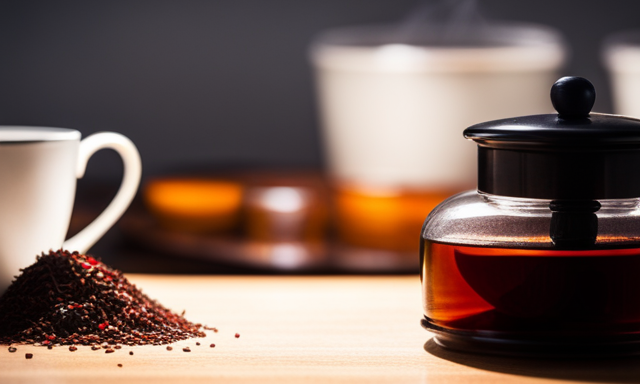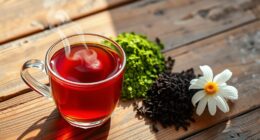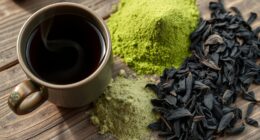When I first took a sip of rooibos tea, it felt as if my taste buds were transported to a serene oasis. The warm, earthy notes wrapped around my tongue, soothing and comforting me with every sip. It was like a gentle hug in a cup, a moment of calm amidst the chaos of the day.
Rooibos, also known as red bush tea, originates from South Africa and has a rich history rooted in the indigenous Khoisan culture. The tea is made from the leaves of the Aspalathus linearis plant, which undergoes a fermentation process that gives it its unique flavor profile.
Unlike traditional teas, rooibos is naturally caffeine-free, making it a perfect choice for those seeking a relaxing beverage without the jitters. Its mild and slightly sweet taste is often compared to honey or vanilla, with a hint of nuttiness.
In this article, we will delve deeper into the nuances of rooibos tea, exploring its flavor notes, health benefits, and even tips for brewing the perfect cup. So, sit back, relax, and let me take you on a flavorful journey through the world of rooibos tea.
Key Takeaways
- Rooibos tea has a mild and slightly sweet taste, often compared to honey or vanilla.
- It has earthy, slightly sweet, and nutty flavors with subtle hints of citrus and floral accents.
- Rooibos tea lacks the grassy and vegetal notes found in green tea.
- Compared to herbal infusions, rooibos offers a more complex flavor profile with hints of vanilla and honey.
Origin and History of Rooibos Tea
The fascinating story of how rooibos tea came to be is a testament to the rich tapestry of history and culture in South Africa.
Rooibos tea, also known as ‘red bush tea,’ has its origins in the Cederberg region of the Western Cape province. It has been enjoyed by the indigenous Khoisan people for centuries, who believed in its healing properties.
The leaves of the rooibos plant are harvested and then fermented, which gives the tea its distinct reddish-brown color. Rooibos tea is known for its numerous health benefits, including its high content of antioxidants and its ability to promote relaxation and relieve stress.
With its unique flavor profile, which is often described as earthy, slightly sweet, and nutty, rooibos tea has become a beloved beverage worldwide.
Now, let’s delve into the process of making this delightful tea.
The Process of Making Rooibos Tea
After going through a meticulous process, rooibos tea bursts with a tantalizing blend of natural flavors. The process of making rooibos tea starts with harvesting the leaves from the Aspalathus linearis plant, followed by fermentation and drying.
Once the leaves are harvested, they’re bruised to initiate oxidation, which is a crucial step in bringing out the tea’s unique taste. The leaves are then spread out to ferment, allowing them to undergo a chemical transformation that enhances their flavor and aroma.
After fermentation, the leaves are dried in the sun, which further intensifies the tea’s natural sweetness. This careful process results in a rich, earthy flavor with subtle hints of honey and vanilla.
In addition to its delightful taste, rooibos tea is also known for its numerous health benefits, such as its high antioxidant content and potential immune-boosting properties.
Transitioning into the next section, the aroma profile of rooibos tea is equally captivating.
Aroma Profile of Rooibos Tea
Indulge your senses with the captivating aroma profile of rooibos tea. It envelops you in a warm embrace of earthy notes, delicate floral undertones, and a subtle hint of sweetness. The aroma of rooibos tea is truly enchanting, creating a sensory experience that’s both comforting and invigorating.
When brewing rooibos tea, it’s important to use the right techniques to fully experience its aromatic qualities. Here are some key points to keep in mind:
- Use freshly boiled water to extract the full aroma of the tea leaves.
- Steep the tea for at least 5 minutes to allow the flavors to fully develop.
- Experiment with different brewing times and temperatures to find your preferred aroma intensity.
As you indulge in the delightful aroma of rooibos tea, you’ll find yourself eagerly anticipating the next step: exploring its rich flavor notes.
Flavor Notes of Rooibos Tea
When it comes to the flavor notes of Rooibos tea, there are several key points to consider. First, it has sweet and nutty undertones that add a delightful richness to each sip.
Additionally, the tea showcases earthy and woody flavors that give it a grounding and comforting quality.
Finally, there are subtle hints of citrus and floral accents that provide a refreshing and uplifting twist to the overall taste profile.
Each sip of Rooibos tea brings a harmonious blend of these flavors, creating a truly enjoyable and nuanced drinking experience.
Sweet and Nutty Undertones
Imagine yourself sipping on a warm cup of rooibos, where the sweet and nutty undertones dance upon your taste buds like a harmonious melody. The taste of rooibos tea is a delightful blend of sweetness and nuttiness, creating a unique flavor profile that’s truly satisfying.
The sweetness is reminiscent of honey or caramel, adding a comforting and soothing element to each sip. As the tea washes over your tongue, the nutty undertones come to life, providing a subtle earthiness and a hint of roasted nuts. These flavors complement each other perfectly, resulting in a tea that’s both comforting and intriguing.
And just when you think the symphony of flavors is complete, the transition into the subsequent section about earthy and woody flavors takes you on a whole new sensory journey.
Earthy and Woody Flavors
The earthy and woody flavors of rooibos tea create a rich and robust taste experience that transports you to a serene forest setting. As you take your first sip, you are greeted by the earthy flavor that is reminiscent of the damp soil after a fresh rain. It is a grounding taste that brings a sense of calmness and tranquility. The natural sweetness of rooibos tea complements the earthiness, providing a perfect balance of flavors. It is like walking through a wooded path, surrounded by the gentle rustling of leaves and the subtle scent of wood. The combination of earthy and sweet notes makes rooibos tea a delightful and comforting beverage. Transitioning to the next section, the addition of citrus and floral accents elevates the taste profile of rooibos tea to new heights.
Citrus and Floral Accents
After experiencing the earthy and woody flavors of rooibos, one might be surprised to discover the delightful citrus flavor and floral aroma that can also be found in this unique tea. The citrus notes are refreshing and tangy, adding a bright and zesty twist to the overall taste. It’s as if a burst of sunshine is captured within each sip.
Additionally, the floral accents bring a sense of elegance and delicacy to the tea, creating a harmonious balance with the citrus flavors. The combination of citrus and floral creates a truly invigorating experience for the senses.
As I’m exploring the world of rooibos, I can’t help but be intrigued by its versatility and complexity. Now, let’s delve into the fascinating comparisons to other teas, where we can uncover even more nuances and flavors.
Comparisons to Other Teas
Rooibos tastes slightly sweeter and less bitter compared to black tea. When comparing rooibos to green tea, rooibos has a fuller body and a natural sweetness that is absent in green tea. It lacks the grassy and vegetal notes commonly found in green tea, making it a great alternative for those who find green tea too astringent.
On the other hand, when compared to herbal infusions, rooibos offers a more complex flavor profile with hints of vanilla and honey. It has a soothing and calming effect that is not commonly found in other herbal teas.
In summary, rooibos stands out with its unique taste that sets it apart from both green tea and herbal infusions. Its subtle sweetness and absence of bitterness make it a versatile beverage that can be enjoyed hot or cold.
Enjoying Rooibos Tea Hot or Cold
Whether you prefer it hot or chilled, rooibos tea is a delightful beverage that can be enjoyed in any weather. Its unique flavor profile makes it a versatile ingredient in various recipes.
When enjoyed hot, rooibos tea has a comforting and soothing effect, making it perfect for cozy evenings or as a morning pick-me-up. The rich and earthy notes of rooibos blend well with other flavors, making it a great base for herbal infusions or mixed drinks.
On the other hand, when served cold, rooibos tea is incredibly refreshing and makes for a great thirst quencher on hot summer days. The best time to drink rooibos tea really depends on personal preference and the occasion.
As we move into the next section about the health benefits of rooibos tea, it’s important to note that this versatile beverage not only tastes great but also offers numerous health benefits.
Health Benefits of Rooibos Tea
Indulging in rooibos tea may just have you feeling so healthy and invigorated, you’ll start questioning why you ever bothered with other beverages in the first place. The health benefits and nutritional properties of rooibos tea are truly remarkable. Packed with antioxidants, it helps boost the immune system and fights inflammation. Its high mineral content, including calcium, magnesium, and zinc, supports strong bones and teeth. Rooibos tea is also known to aid digestion, improve skin health, and promote relaxation.
To give you a better understanding, here’s a table highlighting some of the key health benefits of rooibos tea:
| Health Benefits | Description |
|---|---|
| Boosts Immunity | Strengthens the immune system and fights illness |
| Supports Bone Health | Provides essential minerals for strong bones |
| Promotes Digestion | Aids in digestion and relieves stomach discomfort |
| Enhances Skin Health | Nourishes the skin and helps maintain a healthy glow |
Pairing rooibos tea with food adds another layer of enjoyment to this already remarkable beverage.
Pairing Rooibos Tea with Food
Now that we’ve explored the health benefits of Rooibos tea, let’s dive into the exciting world of pairing this delicious beverage with food. Rooibos tea’s unique flavor profile makes it a versatile option for pairing with a wide range of dishes. Whether you’re enjoying a cup of Rooibos with dessert or using it as an ingredient in refreshing cocktails, the possibilities are endless.
Here are some ideas to get you started:
-
Pair Rooibos tea with chocolate desserts for a rich and indulgent flavor combination.
-
Try pairing Rooibos with fruity desserts like berry tarts or citrus-based desserts for a refreshing and vibrant contrast.
-
Experiment with using Rooibos in cocktails, such as a Rooibos-infused gin and tonic, for a unique twist on classic drinks.
-
Consider using Rooibos as a base for homemade ice cream or sorbet for a delightful frozen treat.
-
Don’t forget to explore the world of Rooibos tea cocktails, such as Rooibos margaritas or Rooibos-infused vodka martinis.
Now that we’ve explored pairing Rooibos with food, let’s take a closer look at the different varieties and blends of Rooibos tea.
Rooibos Tea Varieties and Blends
Let’s delve into the world of Rooibos tea varieties and blends, discovering the endless possibilities that await our taste buds. Rooibos tea blends are created by combining rooibos with other ingredients, such as herbs, fruits, or spices, to enhance its flavor profile.
Popular rooibos flavors include vanilla, honeybush, chamomile, and citrus. These blends offer a diverse range of tastes, from sweet and creamy to refreshing and zesty. Each blend brings its own unique twist to the natural earthy flavor of rooibos, making it a delightful choice for tea enthusiasts.
As we explore the world of rooibos tea blends, we unlock a realm of taste sensations that can complement any occasion or mood. Now, let’s move on to the next section to learn some tips for brewing the perfect cup of rooibos tea.
Tips for Brewing the Perfect Cup of Rooibos Tea
If you want to savor the true essence of a perfectly brewed cup of Rooibos tea, it’s crucial to pay attention to the temperature of the water. Rooibos tea is best brewed with water that has been heated to around 200°F (93°C). This allows the flavors of the tea to fully develop without becoming bitter or overpowering. Another important aspect of brewing Rooibos tea is the steeping time. Generally, a steeping time of 5-7 minutes is recommended to extract the rich flavors and vibrant color of the tea.
To enhance your Rooibos tea experience, it’s worth exploring different brewing techniques and trying out various brands. Some of the best Rooibos tea brands include Numi Organic Tea, Republic of Tea, and Celestial Seasonings. These brands offer a wide range of flavors and blends, allowing you to find the perfect cup that suits your taste preferences. So, take your time, experiment, and enjoy the journey of discovering the perfect cup of Rooibos tea.
| Brewing Techniques | Best Rooibos Brands |
|---|---|
| Water temperature | Numi Organic Tea |
| Steeping time | Republic of Tea |
| Flavor experimentation | Celestial Seasonings |
Frequently Asked Questions
How does rooibos tea compare to green tea in terms of caffeine content?
In terms of caffeine content, rooibos tea is caffeine-free while green tea contains caffeine. Both teas offer health benefits, but the brewing methods differ. Rooibos should be steeped for longer, while green tea requires shorter steeping time.
Can rooibos tea be used as a base for making iced tea?
Yes, rooibos tea can be used as a base for making iced tea. It has a unique flavor profile, with a naturally sweet and nutty taste. Using rooibos tea as a base for iced tea offers the added benefits of being caffeine-free and rich in antioxidants.
Are there any potential side effects or allergic reactions associated with consuming rooibos tea?
There are no known side effects or allergic reactions associated with consuming rooibos tea. It is generally considered safe to drink. Rooibos tea has potential health benefits and can be consumed in recommended dosages.
Can rooibos tea be combined with other herbs or ingredients to make flavored blends?
Rooibos tea can be combined with various herbs and ingredients to create delicious flavored blends. Some popular recipes include adding citrus fruits for a zesty twist or vanilla for a subtle sweetness. These blends not only enhance the taste but also provide additional health benefits.
Is rooibos tea safe for children and pregnant women to consume?
Rooibos tea is safe for children and pregnant women to consume, as it contains no caffeine and is low in tannins. It offers numerous health benefits, such as antioxidant properties and potential relief from allergies and digestive issues.
Conclusion
In conclusion, experiencing the delightful taste of Rooibos tea is like taking a gentle stroll through a fragrant garden at sunset. Its subtle, earthy aroma and velvety smoothness on the palate transport you to a world of tranquility and indulgence.
With its numerous health benefits and versatility, Rooibos tea is a true gem in the world of beverages. So, why not treat yourself to a cup of this exquisite brew and savor the warm embrace of its enchanting flavors?










